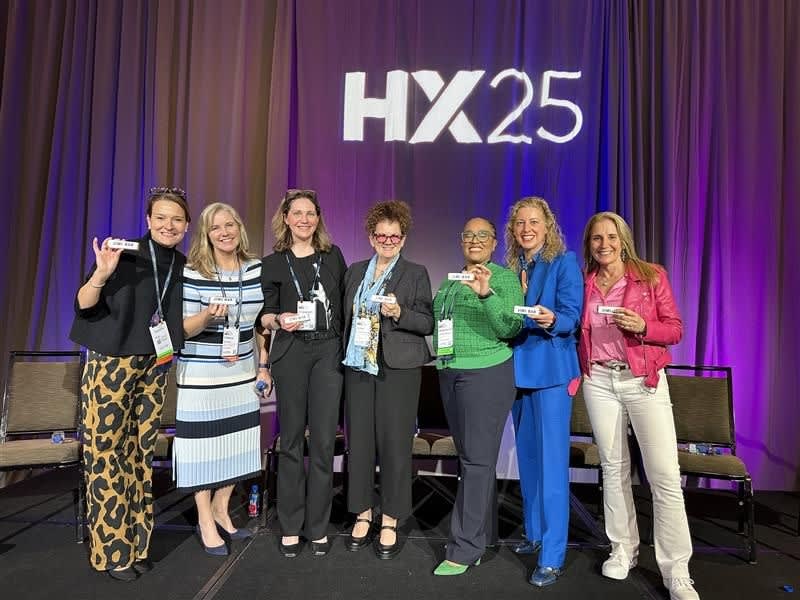6 strategies for building successful employee and physician well-being and retention programs
Press Ganey’s annual Human Experience conference is a powerful event that brings together more than 3,000 healthcare leaders and teams from across the globe. We gather to share stories, network, and learn from one another over three action-packed days in Orlando, Florida. In my 13 years in attendance, both as a client and now, for the past six years, as Press Ganey’s Chief Clinical Officer, I’m always in awe of the incredible work being done to improve healthcare—and, more so, of the inspiring people doing it.
This year, I had the privilege of hosting a panel of six trailblazers making significant strides on well-being and retention of the healthcare workforce.

From left to right: Christina Bowen, MD, ABOIM, Chief Well-Being Officer, ECU Health; Tiffany Pankow, MD, VP, Chief of Caregiver Wellness and Patient Experience, HonorHealth; Elizabeth Harry, MD, SFHM, Chief Well-Being Officer, Michigan Medicine; Julie Kennedy Oehlert, DNP, RN, Chief Experience Officer, ECU Health; Stephanie Jones-Wood, MPH, COHQ, Director, Professional Fulfillment and Engagement, Houston Methodist; Shlomit Schaal, MD, PhD, MHCM, Chief Executive Officer, Houston Methodist Physician Organization and Executive VP, Chief Physician Executive, Houston Methodist; Jessica Dudley, MD, Chief Clinical Officer, Press Ganey.
Their focus and success in supporting employee and physician well-being has never been more important—or timely. Our recent data, set to be published next month, shows a national decline in employee engagement (i.e., an employee’s connection to and satisfaction with the workplace, intent to stay, and “Likelihood to Recommend” their employer). The two groups that are the most impacted are physicians and advanced practice providers (APPs). We’re also seeing that alignment—i.e., the level of connection, trust, and respect between physicians and senior leadership—is also falling, and the pack separating more than ever—meaning some organizations are falling starkly behind.
The same trends extend to resilience as well, affecting both activation (finding meaning in work) and decompression (disconnecting and recharging). While low engagement and alignment signal turnover risks, low resilience points to burnout. These findings are concerning and demand intentional focus. They serve as a call to action in supporting the well-being and overall experience of physicians, APPs, and the entire healthcare workforce in 2025.
Top solutions driving employee and physician engagement, alignment, and resilience
The leaders on this panel are already driving their organizations forward by prioritizing employee and physician engagement, alignment, and resilience. They shared the following six strategies, capturing key factors for organizations to employ as they work toward similar improvement efforts.
1. Organization-/board-level prioritization
Secure sponsorship from senior-most leadership: Get buy-in from the top, including the CEO and the board. Well-being and experience either thrive or falter depending on leadership’s commitment to these priorities.
2. Governance and accountability
Design intentional organizational structures: Make sure your structures make well-being part of sustainable, strategic work—so success doesn’t rely on a single person. This includes reporting out to the board and tying reward compensation to well-being metrics.
3. Alignment
Align physicians and senior leadership: Make sure your physicians understand what you’ve heard and what actions you’ve taken as a result. In other words, get out there! Talk to people and close the loop. This will build trust and mutual respect. Connecting with the front line is critical to ensuring individuals have a voice and are actively involved in decision-making.
4. Leadership development
Create high-value, easily accessible leader development opportunities that include well-being education: Including well-being content in leadership work—that is, making it a core part of development content instead of a separate responsibility—provides leaders with the dedicated time to focus on their own well-being. Online sessions and microlearnings on topics like trust and transparency, GROSS (or, “Getting Rid of Stupid Stuff,” and psychological safety allow leaders to easily engage in content at their own pace.
5. Elimination of waste
Focus on GROSS, human factors, and care redesign: People can’t handle all the complexity thrown at them, and we need to eliminate what’s extraneous. Have hard, honest, conversations on what we can do, or consciously choose what to do. We need to stop pretending we can do it all, when no one actually can.
6. Energized communication
Create a brand around your experience work: Highlight the work you’re doing, so it’s visible to all, and create a sense of “FOMO” (fear of missing out) to energize others to participate in initiatives.
Each panelist shared how they’re advancing one or more of the above strategies across their organizations. A recurring theme was the power of “crowdsourcing”—a dynamic approach gaining traction across the industry. Crowdsourcing is a fast and effective way to engage front-line staff in decision-making and surface high-impact solutions, without relying on traditional surveys.
Organizations have learned to use this tool in several ways, including working together to define what respect means for the organization; identifying barriers that prevent physicians from doing their best work, from pebbles in their shoes to larger redesigns; and developing active solutions for bringing joy back into the practice of medicine. This tool helps these organizations more quickly move from solution to action—which is the most effective way to show employees you’re listening and that what they say makes a difference.
As we look ahead, our most recent data makes one thing crystal clear: There is plenty of work to be done. The good news is that some, like our six panelists, are already using strategies to help organizations move forward faster: Board-level prioritization of this work, governance and accountability, alignment between physicians and leadership, leadership development, the elimination of waste, and communication of the work. By showcasing how organizations are tackling these challenges, we can accelerate all of our efforts to improve the Human Experience of healthcare. We are indeed all in this together.
To discuss these strategies and more solutions, reach out to a member of our workforce and employee experience team.